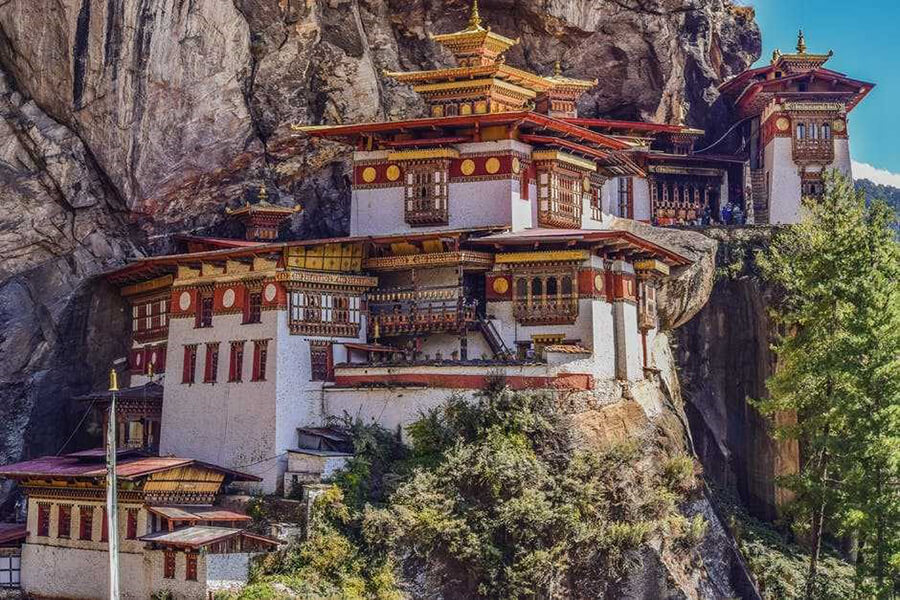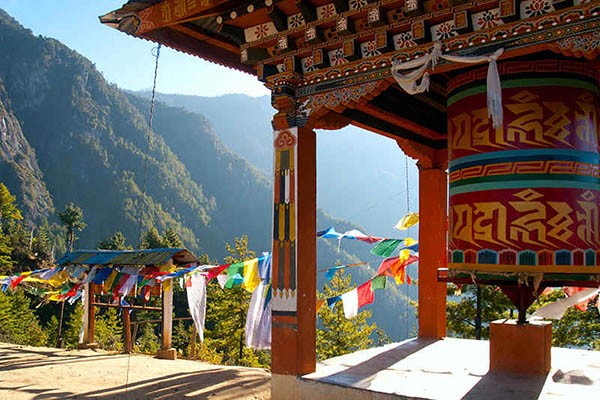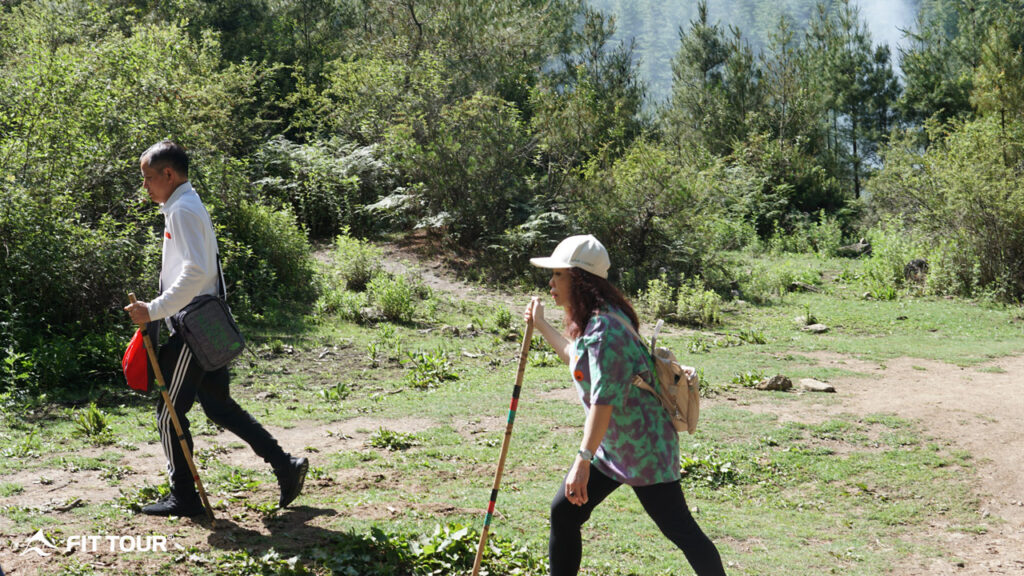Known as the Land of Happiness, Bhutan is a kingdom where Buddhism permeates every aspect of life, demonstrated through majestic architectural masterpieces such as forts and monasteries imbued with cultural and spiritual significance. Among these, Tiger’s Nest Monastery (Paro Taktsang) emerges as an symbol, a place associated with the meditation practices and spiritual journey of Guru Padmasambhava. This place has become a spiritual tourist destination attracting many tourists from all over the world, opening a window into the profound peace and religiosity typical of Bhutan.
Introducing Taktsang Goemba Monastery
The cave, now a holy site within the monastery complex, is where Guru Rinpoche is believed to have meditated. The name ‘Taktsang’ translates to ‘Tiger’s Lair’, stemming from the legend of the tigress. The monastery itself was constructed much later, in 1692, around the cave where Guru Rinpoche meditated. It was built under the leadership of Gyalse Tenzin Rabgye, who is believed to be an incarnation of Guru Rinpoche.
Over the centuries, Taktsang Goemba has become an iconic symbol of Bhutan. It has been restored and expanded several times, particularly after a disastrous fire in 1998 that destroyed most of the original buildings. The monastery was meticulously rebuilt, with the Bhutanese government ensuring that the restoration work preserved its ancient character and spiritual significance.
Where is Taktsang Goemba Monastery located?
Taktsang Goemba, more commonly known as the Tiger’s Nest Monastery, is perched on the cliffside of the upper Paro valley in Bhutan. It is a sacred site and a prominent Himalayan Buddhist temple, situated approximately 3,000 feet above the Paro valley and about 10,240 feet above sea level. This iconic monastery, with its dramatic and picturesque setting, is one of Bhutan’s most revered and famous landmarks, drawing pilgrims and tourists from around the world. Accessible only by foot or mule, the journey to Taktsang Goemba involves a steep hike through beautiful, dense forest, adorned with prayer flags whispering in the wind.
The Best time to visit Tiger’s Nest Monastery
The best time for you to visit Tiger’s Nest Monastery would be during the spring months of March to May or during the fall from September to November. During these periods, you’ll find Bhutan’s weather to be most favorable, with clear skies and a comfortable climate that is ideal for the hike up to the monastery. Spring brings vibrant blooms and lush greenery, enhancing the natural beauty of the landscape that you’ll traverse on your journey. Fall, on the other hand, offers clear views of the majestic Himalayas with a backdrop of a crisp autumnal palette.
Visiting during these seasons will ensure that you get the most out of the experience, with panoramic vistas and a pleasant hike. The trail can be quite challenging, so good weather will make your ascent more enjoyable. Do note that these are also peak tourist seasons, so you may encounter more visitors during this time. However, the awe-inspiring views and the spiritual ambiance of the monastery make any crowd worth braving.
The Legend of Tiger’s Nest Monastery
The legend of Tiger’s Nest Monastery is deeply entwined with the introduction of Buddhism to Bhutan. It is said that in the 8th century, Guru Padmasambhava, also known as Guru Rinpoche, flew to this location from Tibet on the back of a tigress. This tigress is believed to have been a manifestation of his consort, Yeshe Tsogyal, who transformed to carry the Guru from Tibet to Taktsang Senge Samdup cave in order to subdue a local demon.
Once there, Guru Rinpoche meditated in the cave for three months, battling and overpowering the demon and thereby spreading the teachings of Buddhism throughout Bhutan. The site has been held sacred ever since, and it’s said that many of Bhutan’s eminent saints have also chosen this place for meditation.
As shared above, despite being destroyed by fire several times throughout its history, the monastery has been faithfully restored and continues to be a pilgrimage site for both Bhutanese and international visitors, embodying the profound spirituality and cultural significance of Buddhism in Bhutan.
Unique architecture of Taktsang Goemba
Taktsang Goemba stands as an architectural marvel, seamlessly blending with its natural surroundings on the precipitous cliffside of Bhutan’s Paro valley. The monastery complex is built directly into the rock face, nearly 3,000 feet above the valley floor, giving it the appearance of hanging from the cliffs. This remarkable feat of construction is made even more astounding considering it dates back to the late 17th century.
The monastery is composed of white buildings with dark red and gold accents, a traditional color scheme that denotes Buddhist values and the presence of the sacred. Its roofs are gilded with bronze, catching the light and creating a luminous effect against the backdrop of the stark cliffs and the sky.
The structure is a series of buildings interconnected by staircases carved into the rock, with small bridges and winding paths connecting different levels and sections. Balconies and windows are strategically placed, offering stunning views of the valley and the mountains. The main shrine room of the monastery houses a statue of Guru Padmasambhava, around which the entire complex is consecrated.
As you step inside the monastery, a serene world unfolds before you, bathed in the gentle glow of neatly arranged rows of oil lamps. The walls come alive with vivid frescoes, narrating tales of Padmasambhava’s meditation and teachings, along with depictions of Buddha, Bodhisattvas, and various deities integral to Bhutanese folklore and Buddhist traditions. The space is reverently adorned, with each corner holding a piece of Bhutan’s spiritual heart.
Particularly captivating are the Thangka paintings that drape the walls. These aren’t mere decorations; they are storytelling canvases, illustrating the life of the Buddha, revered Lamas, and celestial figures. Devotees believe that venerating these Thangkas is more than an act of reverence; it’s a communion with the divine protectors. They trust in the transformative power of these sacred images to shepherd them through life’s tumultuous tides, offering a mystical shield against all trials and tribulations.
Despite its seemingly precarious location, the monastery is a fortress of spirituality, built to withstand the elements. The walls, thick and made of stone, help to insulate the interior, protecting it from the cold, while also ensuring the buildings’ stability against the cliffside.
This unique blend of natural and man-made beauty, combined with its historical and spiritual significance, makes the architecture of Taktsang Goemba not only unique but also deeply emblematic of Bhutan’s cultural and religious heritage.
How to get to Tiger’s Nest Monastery
To reach Tiger’s Nest Monastery, you’ll begin your journey in Paro, the town that’s home to Bhutan’s only international airport. From Paro, you can make your way to the base of the mountain where the trail to Tiger’s Nest begins. This is a short drive, typically around 20 minutes, and you can hire a taxi or arrange for a car through your hotel or tour operator.
Once you arrive at the base, you’ll be faced with a moderately challenging hike up to the monastery. The trail is well-maintained and marked, snaking through beautiful pine forests filled with Spanish moss and the fluttering of prayer flags. The hike takes about 2 to 3 hours for an average walker, though this can vary depending on your pace and fitness level. You’ll ascend approximately 900 meters, so it’s advisable to take it slowly and acclimatize, especially if you’re not used to the altitude.
Halfway up the trail, you’ll find a cafeteria where you can rest, grab a snack, and enjoy a striking view of the monastery, which seems almost within reach. This is a great spot to catch your breath and take some photos.
The final leg of the trek involves a steep set of stairs that lead directly to the monastery. As you approach, you’ll cross a charming bridge adorned with prayer flags, with a waterfall cascading underneath—a perfect prelude to the serenity of Tiger’s Nest.
Remember, the monastery is a sacred site, so you’ll need to dress modestly and leave your camera and backpack at the entrance. Inside, you can explore the temples and caves, immersing yourself in the tranquility and rich history of this extraordinary place.
After your visit, you’ll descend the same path back to the base. The return journey is usually faster, but it’s important to be cautious as the trail can be tough on the knees.
Festivals or special events at Taktsang Goemba
The most notable event at Taktsang Goemba is the Tsechu festival. Tsechu, meaning “tenth day”, is an annual religious Bhutanese festival held in each district on the tenth day of a month of the lunar Tibetan calendar. The exact month of the Tsechu varies from district to district, but they all celebrate the deeds of the 8th-century Buddhist saint Padmasambhava, also known as Guru Rinpoche, to whom Taktsang Goemba is dedicated.
During Tsechu, the monastery comes alive with vibrant colors and festivities. Monks don colorful silk costumes and masks to perform Cham dances, which are ritual dances featuring elaborate, stylized movements that depict tales of morality, compassion, and the triumph of good over evil. These dances are believed to bestow blessings upon the spectators and to instruct them in the teachings of Buddhism.
Apart from the dances, there are readings of Buddhist scriptures, the display of giant thangkas (religious paintings), and a general atmosphere of celebration and reverence. It’s a deeply immersive experience that offers you a glimpse into Bhutan’s rich cultural and spiritual tapestry.
Visiting during Tsechu is a unique opportunity to witness a centuries-old tradition in one of the most sacred Buddhist sites in the world. It’s a chance to see the local Bhutanese culture in its most vivid and vibrant form, against the backdrop of the serene and majestic Taktsang Goemba.
The Nearby attractions to Taktsang Goemba Monastery
After you’ve soaked in the spiritual splendor of Taktsang Goemba Monastery, you might be inclined to explore more of what the Paro valley has to offer. Fortunately, the area around Tiger’s Nest is rich with cultural and natural attractions that can enrich your Bhutanese experience.
Just a short drive away, you’ll find the Rinpung Dzong, a fortress that houses both monastic and administrative offices. Known for its intricate woodwork and impressive architecture, it’s a fine example of Bhutanese architecture and offers insight into the country’s past. Every spring, the dzong becomes the center stage for the Paro Tsechu, a vibrant festival filled with masked dances and cultural displays.
If you’re interested in Bhutanese history and art, you should visit the National Museum of Bhutan, housed in the Ta Dzong, an ancient watchtower. Here, you’ll find a vast collection of Bhutanese artifacts, thangkas, traditional costumes, and armory that provide a deep dive into the kingdom’s rich heritage.
For a tranquil experience, you might want to visit Kyichu Lhakhang, one of Bhutan’s oldest and most beautiful temples. Legend has it that it was built overnight by a Tibetan king to subdue a demoness. The temple is surrounded by fields and orchards, offering a peaceful retreat.
If you’re looking for something more adventurous, consider taking a hike along the banks of the Paro Chhu river, where you’ll find the crumbling ruins of Drukgyel Dzong. This dzong was once a fortress of great importance, but now its ruins offer a hauntingly beautiful glimpse into the past.
Finally, if you’re interested in Bhutanese crafts and want to take a piece of Bhutan home with you, stop by one of Paro’s traditional handicraft shops. You’ll find exquisite textiles, intricate jewelry, and a variety of other handcrafted goods.
These attractions around Taktsang Goemba offer you a well-rounded experience of Bhutan’s cultural, historical, and natural beauty, making your journey to the Land of the Thunder Dragon all the more memorable.
Notes for visitors when visiting Tiger’s Nest Monastery
When you’re planning a visit to Tiger’s Nest Monastery, there are several important notes to keep in mind to ensure a respectful and enjoyable experience:
- Travel Time to Monastery: Varies based on physical fitness. Most people complete the trek in approximately 3 hours.
- Entrance Fee: Free for Bhutanese in national dress; 500 Ngultrum (approx. $7) for foreigners.
- Opening Hours: Morning: 8:00 AM to 1:00 PM – Afternoon: 2:00 PM to 6:00 PM
- Dress Appropriately: You should wear modest clothing that covers your arms and legs. It’s a sign of respect, as Taktsang is a sacred religious site. Comfortable walking shoes are a must for the hike.
- Physical Fitness: The hike to the monastery is steep and can be challenging. Ensure you’re in good physical condition to make the climb. Take it slow, and if you have any health issues, consult with your doctor before attempting the trek.
- Acclimatization: Taktsang is situated at a high altitude. If you’re not used to such elevations, spend a day or two in Paro to acclimatize before attempting the hike.
- No Photography Inside: While you can take photos of the exterior, photography is strictly prohibited inside the monastery. You’ll also need to leave your bags and cameras at the entrance.
- Respect the Silence: Maintain a respectful silence inside the monastery. It’s a place of worship and meditation, and loud noises are considered disrespectful.
- Bring Water and Snacks: The hike can take several hours, and there are few facilities once you start. Bring enough water to stay hydrated and some snacks to keep your energy up.
- Start Early: To avoid the midday heat and crowds, start your hike early in the morning. This also gives you the best chance of clear views before any afternoon clouds roll in.
- Guided Tours: Consider hiring a guide. They can provide valuable insights into the history and significance of the monastery, as well as help you navigate the trail.
- Respect Local Customs: Be mindful of local customs and traditions. Bhutan is a deeply Buddhist country, and showing respect to local beliefs and practices is crucial.
- Environmental Care: Keep the trail clean. Carry out any trash you bring in, respecting the natural beauty of the area.
Perched on the cliffs of the Himalayas, Tiger’s Nest Monastery stands as a testament to Bhutan’s breathtaking natural beauty and its deep spiritual heritage. Despite its modest size, Bhutan, with its pristine landscapes and majestic monasteries, offers a sanctuary from the worldly woes. As you tread the paths once walked by sages and monks, the monastery’s serene presence seems to lift the burdens of everyday life. It’s as if, with each step taken towards its sacred walls, the weight of worldly concerns diminishes, leaving travelers with a profound sense of peace and rejuvenation.














